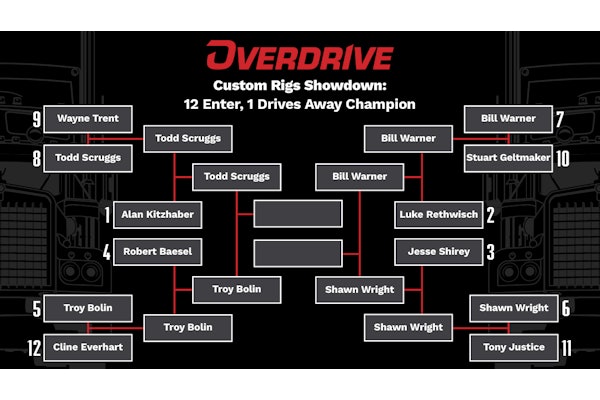 This is not a Navistar truck.
This is not a Navistar truck.In a July 2 motion, Navistar asked the U.S. Court of Appeals for the District of Columbia Circuit to deny EPA’s attempt to amend its own record in the case. EPA filed the “certified amended index to administrative record” – a list of documents the agency says are relevant to the case – on June 15, almost a month after it filed its original certified index.
Navistar’s lawsuit relates specifically to EPA’s Feb. 18 certification standards for SCR-equipped engines.
Navistar contends EPA adopted the Feb. 18 guidance improperly, without rulemaking procedures that were used in 2001 and 2007 to adopt the original 2010 requirements and earlier SCR guidance, respectively.
In its latest filing, Navistar argues EPA’s new index improperly removes many documents from the original index, “including documents likely to reveal EPA’s own conclusions effectively confirming the merits” of the lawsuit. Navistar says the removed documents reveal the “inefficacy and environmental hazard” posted by SCR, which EPA had called infeasible in 2001 “but later authorized in secret collaboration with certain engine makers outside of rulemaking.”
Much of Navistar’s July 2 filing revolves around establishing there was no public record surrounding EPA’s adoption of the Feb. 18 guidance – unlike the situation with the 2001 standard and the 2007 SCR guidance. What EPA submitted in May included documents the agency itself selected, many of which represented correspondence among EPA, the California Air Resources Board and the Engine Manufacturers Association, Navistar said. In filing the initial index, “EPA had the choice of conceding the truth – namely, that there is no administrative record – or of creating a record on the spot. EPA chose the latter course.”

Documents that EPA did include in its amended certified index include correspondence between EPA and EMA regarding the language of the 2009 SCR guidance and between EPA and CARB, referring in some cases to “the EMA guidance document.”
“EMA provided recommendations and comments regarding the development of additional guidance to supplement EPA’s original SCR guidance document prepared in March 2007,” says Joe Suchecki, EMA spokesman. “EMA regularly works with EPA, CARB and a wide variety of interested stakeholders regarding issues affecting the industry.”
— Avery Vise
Flying J to merge with Pilot
Flying J Inc. and Pilot Travel Centers plan to merge, the companies announced July 14. The plan would allow Flying J’s travel plaza business to emerge from Chapter 11 bankruptcy protection, according to a statement from both companies.
Under the plan filed with the U.S. bankruptcy court in Delaware, all Flying J creditor obligations would be paid in full. Pilot has also agreed to provide $100 million in financing for Flying J’s operations, subject to court approval and various conditions.
The preliminary merger agreement with the Knoxville, Tenn.-based Pilot doesn’t cover Flying J companies Longhorn Pipeline, Big West Oil, Flying J Oil & Gas, Haycock Petroleum and Transportation Alliance Bank. Flying J is considering alternatives for each of these other businesses.
Flying J filed for Chapter 11 Dec. 22 after a sharp drop in oil prices and turmoil in the credit markets damaged the company’s cash position.
— Lanier Norville
Shippers’ poll shows support for heavier trucks
More than half of Americans support raising interstate truck weight limits without making trucks larger, according to a national poll paid for by the Coalition for Transportation Productivity, a group of more than 100 shippers and allied associations seeking increased federal weight limits on interstate highways.
CTP says the results of its commissioned national poll reveal broad support for truck weight reform as outlined in The Safe and Efficient Transportation Act of 2009 (H.R. 1799).
“With truck traffic already increasing 11 times faster than road capacity and freight expected to double by 2025, H.R. 1799 would make sure America’s shipping needs are met in a way that improves highway safety and reduces our carbon footprint,” says CTP Co-Chair John Runyan.
Among the survey’s key findings, according to CTP:
By a margin of 51 percent to 39 percent, a majority of Americans would favor increasing the weight limit if it contributes to safer roads, greater fuel economy and more productive highway transportation.
Americans are more likely to support increasing weight limits when they learn that an additional axle would make the tractor-trailers safer and better for road surfaces. Two-thirds would be more likely to support legislative action to allow trucks to carry more weight on interstates if those trucks add an extra axle.
— Staff reports
Citations drop in latest Roadcheck
Roadcheck 2009’s record total of overall inspections showed significant declines in vehicle and driver out-of-service rates, according to the Commercial Vehicle Safety Alliance.
Data show the highest overall vehicle compliance rate, 80.4 percent, since 1996, and the highest ever overall driver compliance rate, 95.7 percent. For North American Standard Level I inspections, the compliance rates of 77.8 percent (vehicles) and 96.1 percent (drivers) were both records for Roadcheck. In addition, safety belt violations were reduced by 22.2 percent over last year.
— Staff reports
Trucking fatalities decline 12% in 2008
The number of overall traffic fatalities reported in 2008 dropped to the lowest level since 1961, says the U.S. Department of Transportation. Further decrease was evident in preliminary data from the first three months of 2009.
The overall highway fatality rate, which provides a more accurate picture of safety by accounting for the number of vehicle miles traveled, also reached the lowest level ever recorded.
Fatalities in crashes involving large trucks declined 12 percent in 2008 from the year before, from 4,822 deaths to 4,229. The number of truck occupants who died in these crashes decreased 16 percent, to 677 from 805.
The overall highway death count for 2008 was 37,261, a drop of 9.7 percent from 2007. The fatality rate for 2008 was 1.27 persons per 100 million vehicle miles traveled, about 7 percent below the rate of 1.36 recorded for 2007.
The comparable truck-related fatality rate will be announced when that data is available.
Substantial fatality declines occurred in virtually every major category, led by declines in passenger car occupant fatalities, which dropped for the sixth year in a row. Light truck occupant fatalities fell for the third straight year. Alcohol-impaired fatalities also declined by more than 9 percent over 2007.
Continuing this trend, the January-March 2009 estimate of 7,689 deaths represents a 9 percent decline from a year ago. It was the 12th consecutive quarterly decline.
For more information, visit www-nrd.nhtsa.dot.gov.
— Staff reports










